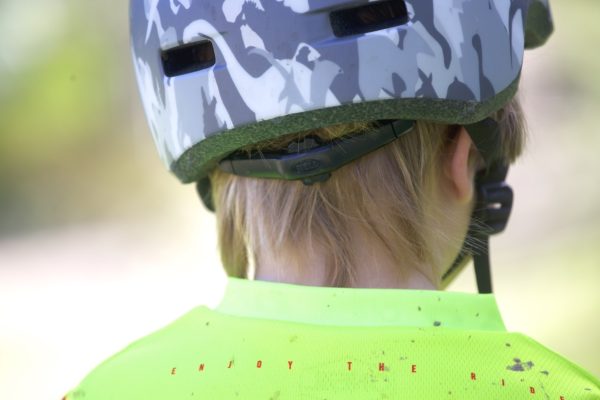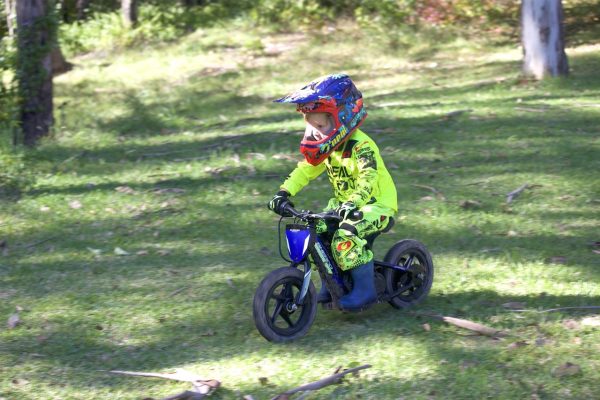In recent years, the popularity of electric balance bikes among very young children has surged. 12-inch electric balance bikes have enabled kids as young as two to get behind the ‘bars and twist the throttle now. In years gone by, a three or four year old was considered too young to hop on a Yamaha PW50. So all of a sudden parents now need to start thinking about an open face helmet versus a closed face helmet.
Parents are excited about introducing their toddlers to the world of moto at an early age, hoping to instil a love for dirtbikes and improve their motor skills. However, with this new adventure comes a critical concern: safety. Ensuring the protection of your little one is paramount, and one of the most debated topics is choosing the right helmet.
When my son Jaxon got his first electric balance bike at the age of two, I began looking for a helmet to wear. Unfortunately my search was short lived as I struggled to find a helmet small enough to fit snug on his head and light enough to not damage his neck. So I got him an open face bicycle helmet and a closed face dirtbike helmet to see which was better.


Safety Considerations for Young Riders
Parents want to give their children the best start, but they also want to ensure they are protected. The right helmet can make a significant difference in safety, especially for toddlers who are just beginning to explore the world of electric balance bikes. After all, you don’t want them losing their front teeth! Understanding the differences between open face and closed face helmets can help parents weigh their options effectively.

Open Face Bicycle Helmet
Pros
- Lightweight Design: Open face bicycle helmets are generally lighter than their full-face counterparts. This lightweight design is less taxing on a toddler’s neck, making it easier for them to support the helmet and maintain proper posture while riding. This aspect is particularly important for very young children whose neck muscles are still developing and may not be strong enough to support heavier helmets for extended periods. The Bell Lil Ripper helmet in these images only weighs 221 grams.
- Ventilation: These helmets offer excellent ventilation due to their open design. Overheating can be a significant issue for young children, who may become irritable or distracted if they are too hot.
- Ease of Use: The simplicity of an open face helmet makes it easy to put on and take off. Parents will appreciate the quick and hassle-free application, especially when dealing with toddlers who are eager to start their ride.
- Visibility: The open design provides a wider field of vision, allowing young riders to see their surroundings more clearly. This increased visibility can enhance their sense of security and awareness. For children just learning to balance and steer, being able to see more of their environment can help them navigate obstacles and avoid accidents.
- Hearing: The open face helmet is easier for them to hear you yelling at them when they’re heading or a fence!

Cons
- Limited Protection: The most significant drawback of an open face helmet is its limited protection, especially for the jaw and face. In the event of a fall or collision, the face is exposed and vulnerable to injury. For young children who may be more prone to falls due to their developing motor skills, this lack of protection can be a serious concern.
- Less Secure Fit: Open face helmets may not offer the same level of secure fit as closed face helmets. While they are designed to stay in place, the absence of a full enclosure can sometimes result in a looser fit. This can be problematic if the helmet shifts during a ride, potentially reducing its effectiveness in protecting the head during an impact.
- Durability: The materials used in open face helmets are often less robust than those in full-face helmets.

Closed Face Dirt Bike Helmet
Pros
- Comprehensive Protection: Closed face dirt bike helmets provide extensive protection, covering the entire head, including the jaw and face. This full coverage significantly reduces the risk of serious injury in a fall or collision.
- Robust Construction: These helmets are built with durable materials that can withstand higher impact forces. The thick padding and sturdy outer shell contribute to enhanced safety for young riders. Notably, the ABS shell construction of this O’Neal 1 SRS helmet which weights 1500 grams (±50) is durable and strong.
- Advanced Technology: Many closed face helmets incorporate advanced safety technologies such as multi-density foam liners and reinforced chin bars. These features help to absorb impact energy and distribute it more effectively, minimizing the risk of injury. Some helmets also include ventilation systems and moisture-wicking liners to improve comfort without compromising safety.
- Secure Fit: The full-face design ensures a more secure fit, reducing the likelihood of the helmet shifting or coming off during a ride. A secure fit also means the helmet is more likely to stay in the optimal position to protect the head and face during an impact.
- Adjustable and Durable Design: These helmets come with adjustable visor designs and intake and exhaust vents for ventilation and cooling. Replacement parts are also available, ensuring that the helmet can be maintained and used for a long time.
- Safety Certification: Reputable closed face dirtbike helmets meet the DOT safety standard.

Cons
- Weight: The most notable disadvantage of closed face helmets is their weight. They are significantly heavier than open face helmets, which can strain a young child’s neck and lead to discomfort or fatigue over time. This can be particularly problematic for very young children who may not have the neck strength to support a heavy helmet for long periods.
- Reduced Ventilation: The enclosed design limits airflow, which can cause the rider’s head to become hot and sweaty, especially in warm weather. This reduced ventilation can be uncomfortable and may deter some children from wearing the helmet consistently.
- Bulkiness: Closed face helmets are bulkier, which can make them cumbersome for small children. The added bulk can also affect their balance and coordination, making it more challenging for them to manoeuvre their bikes.
- Limited Visibility: While they provide better protection, closed face helmets can restrict the rider’s field of vision. This limited visibility can be disorienting for young children and may increase the risk of accidents. Parents should look for helmets with larger eye ports or adjustable visors to help mitigate this issue.

Weighing the Options
When choosing between an open face bicycle helmet and a closed face dirt bike helmet for a two-year-old, parents need to consider several factors. The primary considerations are the level of protection needed, the weight of the helmet, the comfort and fit, and the specific riding environment.
For casual riding in safe, controlled environments such as parks or paved pathways, an open face bicycle helmet may suffice. Its lightweight design, superior ventilation, and ease of use make it a practical choice for young children who are just starting out. However, parents must be aware of its limitations in terms of protection, particularly for the face and jaw. In these settings, the likelihood of high-impact collisions is lower, making the open face helmet a reasonable choice.
In contrast, for higher-risk activities or more challenging terrains such as BMX tracks or off-road trails, a closed face dirt bike helmet is the better option. The comprehensive protection and advanced safety features provide greater peace of mind, but parents must weigh this against the potential drawbacks of added weight, reduced ventilation, and limited visibility.
Another critical factor is the child’s comfort and willingness to wear the helmet. A helmet that is too heavy or uncomfortable is less likely to be worn consistently, defeating its purpose.


Words & Photos | Mitch Lees











